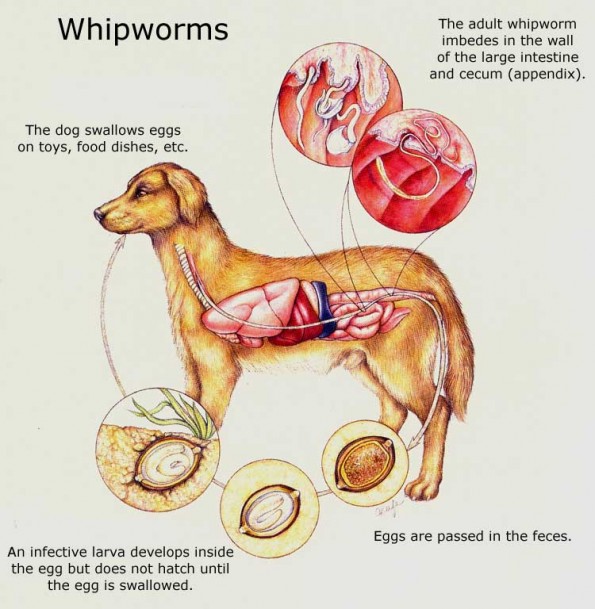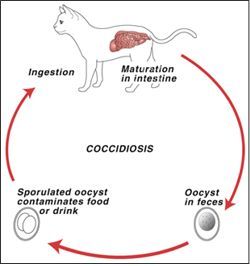
Ascariasis
Ascarid infection is common in pets (dogs and cats) causing diarrhea and vomiting in young animals. Older animals generally have asymptomatic infections. Transmission of ascarids (roundworms) is by oro-faecal, transmammary and transuterine routes. Their diagnosis can be done by the finding of typical ova in faecal floatations. Ascarids have significant zoonotic implications, as visceral larva migrans is a serious disorder in children.
Standard therapy
Pyrantel pamoate is a safe anthelmintic that is 95% effective against ascarids and hookworms. The standard dose is 15 mg/kg PO 30 minutes after a light meal. Treatment should be repeated in 21 days.
Ascarid control in puppies and kittens should begin at 2-3 weeks of age, and treatment with pyrantal pamoate is given at 3 week intervals until 12 weeks of age.
Preventive therapy
Diethylcarbamazine, 6.6 mg/kg/day is effective in preventing ascarid infections. Oxibendazole is also effective. Good sanitation is recommended.

Ancylostomiasis
Ancylostomiasis (hookworm infection) is common in dogs and cats resulting in serious enteritis and blood loss in puppies and kittens. Mortality rates can be high when diagnosis and treatment are delayed. Transmission is through oro-faecal, percutaneous, and transmammary route. Diagnosis is by finding typical ova in fecal floatation technique. Occult infections are known to occur, so the diagnosis of the hookworms should not be discounted when fecal floatation are negative.
Standard therapy
Because of its efficacy and low toxicity, pyrantal pamoate is the initial anthelmintic of choice in most dogs and cats. A dose of 15 mg/kg PO is administered and repeated in 21 days. When vomiting precludes oral anthelmintic therapy, disophenol 10 mg/kg SC can be used. The margin of safety of disophenol is low (36 mg/kg is fatal), so small dogs, cats, puppies and kitten should be weighed carefully. Butamisole 2.4 mg/kg is effective for hookworms and whipworms. Its use is approved for dogs but it is contraindicated for heartworm infection, debilitated dogs, or puppies less than 8 weeks old. Both disophenol and butamisole cause pain at injection site.
Hookworm disease is associated with anemia, iron deficiency and bloody diarrhea. In addition to anthelmintic therapy, blood transfusions, fluid therapy, and hematinic therapy may be indicated for dehydration and gastrointestinal loss of iron and hemoglobin.
Alternative therapy
Fenbendazole is effective against hookworms, ascarids, whipworms, Taenia tapeworms and Strongyloides. The dosage is 50 mg/kg/day for 3 days. It is currently approved for dogs and has been safely given to cats. Toxicity is rare but hepatotoxicity has been reported with the bendazole derivatives. Mebendazole has a spectrum of activity similar to fenbendazole. The dosage is 22 mg/kg in the food daily for 3 days (5 days for Taenia therapy). Mebendazole is approved for dogs. Occasional drug-induced acute hepatic necrosis has been reported in dogs. Milbemycin oxime 0.5 mg/kg PO each month can control hookworm and heartworm infection simultaneously.

Trichuriasis
Trichuriasis(whipworm infection) causes acute and chronic colitis in dogs. Infections may be occult and the absence of ova in fecal floatation does not rule out the diagnosis. Occult tricuriasis can be confirmed by finding the parasites during colonoscopy or by following the response to appropriate therapy. Transmission is through feco-oral route.
Standard therapy
Fenbendazole 50 mg/kg for 3 consecutive days is recommended. Butamisole 2.4 mg/kg SC is also effective. Dogs should be retreated in 21 and 70 days.

Tapeworms
Two major type of tapeworms cause intestinal infections in dogs and cats. Taenia tapeworms are transmitted by rodents and rabbits, and the Dipylidium caninum tapeworm is transmitted by ingestion of infected fleas. Clinical signs are generally mild, most animals remain asymptomatic.
Standard therapy
Praziquantel is effective against tapeworms at the rate of 5 mg/kg PO or IM in dogs. The dose for cats is 11 mg total for a cat weighing 1-3 lbs, 22 mg total for cats weighing 3-11 lbs and 33 mg in total for cats weighing over 11 lbs. Epsiprantel is also effective at a dosage of 5.5 mg/kg PO in dogs and 3.3 mg/kg PO in cats.
Alternative therapy
Bunamide 25-50 mg in total is effective against Taenia in an empty stomach and only 55-90% effective against Dipylidium. Fenbendazole and mebendazole are effective against Taenia if given orally for 5 days. Febantel and praziquantel is effective against ascarids, hookworms, whipworms, and tapeworms.

Coccidiosis
At least four species of Cytoisospora infect dogs and cats. Usually coccidian produce enteric disease in puppies and kittens or in severely stressed or immunocompromised adults. When enteric sighns develop and coccidian are demonstrated in the faeces, a thorough search should be undertaken for infection with other gastrointestinal parasites. Diagnosis is made by demonstrating the oocysts in feces.
Standard therapy
Sulphadimethoxine 50 mg/kg PO on day 1 followed by 25 mg/kg PO daily for 2 days is recommended in both dogs and cats. Treatment of any other gastrointestinal parasite is important.
Alternative therapy
Amprolium is a coccidiostatic drug useful for treating puppies in large kennels. It is nor approved for canine use but effective and relatively safe. Amprolium powder 100 mg/capsule for small breed puppies and 200 mg/capsule for large breed puppies daily for 7-10 days is given orally or mixed with food. Amprolium solution 9.6% can be mixed with drinking water at a rate of 7.8 ml/L of water for 7-1 days.

Strongyloides
Strongyloides may cause acute watery diarrhea in puppies and kittens. The larvae are usually identified in feces via a Baerman Apparatus or a modified Baerman technique.
Standard therapy
Fenbendazole 50 mg/kg/day for 5 days is effective. Retreatment in 30 days is recommended.
Important Note
- Always consult your veterinarian before taking any treatment.
- Anti-parasitic drugs have certain side-effects and should be taken under the guidance of veterinary practitioner.
- Deworm your pets at every 3 months to reduce parasitic load.
For any type of query related to animal husbandry, you can ask us by clicking ‘ask a question’ or ‘contact us’ option. For receiving a soft copy of any article, mail us at [email protected].
If you want to write an article or share your experience related to animal husbandry with other farmers, write your article and email it to [email protected].
If any student of veterinary science or veterinary doctor wishes to publish an article with us, then write your article and email at [email protected]. You can send your articles in Hindi, Punjabi, Urdu or English.

Leave a Reply